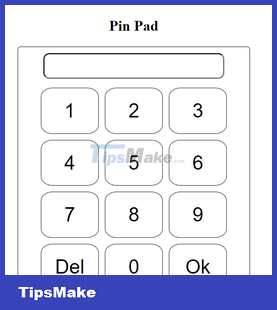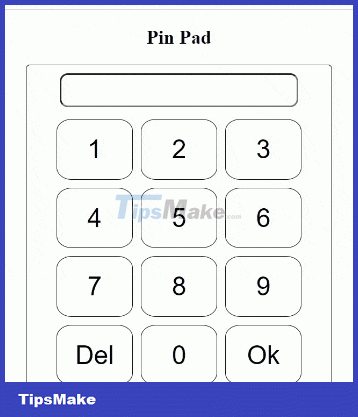How to make PIN Pad using HTML CSS & JavaScript
The basic working mechanism of a PIN Pad is that when the user enters a PIN and presses OK, this code validates the validity of the PIN, and provides a notification whether the PIN is entered correctly or incorrectly.

Prepare:
- CSS
Use cases
- Create HTML structure using tags
give the project name and main container containing all the components. This container has a maximum width of 100%.
- Create a tag like structure with a width of 30% of the main container and center it on the page by setting the left & right margins to 'auto'.
- Here we use flexbox to format different buttons and cards.
- Create a textbox at the top that will display the entered pin in password format.
- Create multiple rows, where each row contains 3 buttons with the last row containing a Del button to delete the last entered number and an OK button to send the PIN.
- Add appropriate styles to elements using their class and ID value.
- In the JS file, first set the predetermined correct PIN value to the desired numeric value.
- When the current number buttons are clicked, it will add that number to the PIN value shown on the input control button at the top.
- When you click Del, the most recently entered data will be removed from the resulting textbox. When clicking Ok, it will validate the entered PIN based on the previously determined PIN, and notify the user whether the PIN has been entered correctly or not.
- Users cannot enter anything directly into the input box.
- The user can click on that button and it will be shown in the input box at the top.
- All JS click events are processed from JavaScript files.
Project structure

For example, the code below implements a basic PIN card application using HTML, CSS, and JavaScript.
JavaScript
// Script.js // Correct Pin Value let correctPin = "1234"; let btns = document.getElementsByClassName( "pinpad-btn" ); let pinInput = document.getElementById( "pinpad-input" ); for (let i = 0; i < btns.length; i++) { let btn = btns.item(i); if ( btn.id && (btn.id === "submit-btn" || btn.id === "delete-btn") ) continue; // Add onclick event listener to // Every button from 0 - 9 btn.addEventListener( "click", (e) => { pinInput.value += e.target.value; } ); } let submitBtn = document.getElementById( "submit-btn" ); let delBtn = document.getElementById( "delete-btn" ); let modal = document.getElementById("modal"); let result = document.getElementById("result"); let closeBtn = document.getElementById("close"); submitBtn.addEventListener( "click", () => { if ( !pinInput || !pinInput.value || pinInput.value === "" ) { alert( "Please enter a pin first" ); } else if ( pinInput.value === correctPin ) { alert("Correct PIN"); } else { alert("Incorrect PIN"); } // Reset the input pinInput.value = ""; } ); delBtn.addEventListener("click", () => { if (pinInput.value) pinInput.value = pinInput.value.substr( 0, pinInput.value.length - 1 ); }); closeBtn.addEventListener( "click", () => { modal.style.display = "none"; } ); HTML
Pin Pad Battery Pad
×
CSS
/* Style.css */ .text-center { text-align: center; } .container { width: 100%; } .card { border: 1px solid black; border-radius: 5px; width: 30%; margin-right: auto; margin-left: auto; display: flex; flex-direction: column; } .card-header { display: flex; justify-content: center; margin: 10px; text-align: center; } .row { display: flex; flex-direction: row; justify-content: center; } .pinpad-btn { width: 25%; height: 75px; margin: 5px; padding: 5px; border: 1px solid black; border-radius: 20%; font-size: 2em; display: flex; justify-content: center; align-items: center; cursor: pointer; background-color: white; } .pinpad-btn:hover { background-color: lightgray; } #pinpad-input { border-radius: 10px; height: 1.5em; font-size: 1.5em; text-align: center; width: 80%; } Steps to run the application: Open Live Server, then enter the following URL into the link:
http://localhost:5500/Result:

It's done! Hope the article is useful to you.
5 ★ | 1 Vote
You should read it
- JavaScript in HTML
- 5 steps to learn a dynamic HTML web component profile
- How to create custom tags with HTML and CSS
- 5 free online HTML editing tools that test the best code
- HTML form
- Successfully created 2-way chat framework on the web with only CSS and HTML
- What is JavaScript?
- Tutorial for creating slideshows in JavaScript with 3 easy steps
May be interested
- How to create a simple contact form using HTML, CSS, and JavaScript
 learn how to create a contact form for the web with ease by following these steps, ensuring you communicate effectively with your visitors.
learn how to create a contact form for the web with ease by following these steps, ensuring you communicate effectively with your visitors. - Top site with many good JavaScript exercises to practice
 many people, after taking javascript courses and being equipped with some knowledge of the language they pursue, are eager to improve and cultivate these learned skills. so this article will give you a list of the top 3 websites to actually make javascript.
many people, after taking javascript courses and being equipped with some knowledge of the language they pursue, are eager to improve and cultivate these learned skills. so this article will give you a list of the top 3 websites to actually make javascript. - Introduction to HTML
 a few basic things to know about html before starting to learn this language.
a few basic things to know about html before starting to learn this language. - String object in JavaScript
 the string object helps you work with a series of characters; it helps handle the original string data types in javascript with some help methods.
the string object helps you work with a series of characters; it helps handle the original string data types in javascript with some help methods. - Summary of JavaScript exercises with sample code
 in order to make your javascript learning easier, tipsmake.com has compiled a number of javascript exercises with sample solutions for you to practice.
in order to make your javascript learning easier, tipsmake.com has compiled a number of javascript exercises with sample solutions for you to practice. - Basic examples of HTML
 in the previous html lesson, you know which tools to use to write html code, how to save and open html files. this article will give some basic examples of html text.
in the previous html lesson, you know which tools to use to write html code, how to save and open html files. this article will give some basic examples of html text. - Reference Canvas in HTML
 the html canvas tag is used to draw graphics on the fly, via scripting (usually javascript). to learn more about canvas, please read the html canvas tutorial.
the html canvas tag is used to draw graphics on the fly, via scripting (usually javascript). to learn more about canvas, please read the html canvas tutorial. - Tutorial for creating slideshows in JavaScript with 3 easy steps
 if you are studying or interested in programming, do not skip the article below to guide how to create slideshows in java script with 3 simple steps.
if you are studying or interested in programming, do not skip the article below to guide how to create slideshows in java script with 3 simple steps. - How to Make a Scrolling Marquee in HTML
 a scrolling marquee is moving text added to a website, but html is no longer commonly used for this feature and is not recommended. the html tag for scrolling marquees has been deleted from the standard html library. to accomplish a...
a scrolling marquee is moving text added to a website, but html is no longer commonly used for this feature and is not recommended. the html tag for scrolling marquees has been deleted from the standard html library. to accomplish a... - What is Currying in Javascript? How to use Currying in JavaScript
 the currying feature in javascript can help you keep your code tidy and give you a new way of seeing how functions work. currying is ideal when you want to break complex logic into smaller, manageable, and self-contained pieces of code.
the currying feature in javascript can help you keep your code tidy and give you a new way of seeing how functions work. currying is ideal when you want to break complex logic into smaller, manageable, and self-contained pieces of code.










 How to implement Infinite Scroll in web application
How to implement Infinite Scroll in web application What is CSS? Introduction to CSS
What is CSS? Introduction to CSS How to use functions in Less CSS
How to use functions in Less CSS How to create custom tags with HTML and CSS
How to create custom tags with HTML and CSS Synthesize the most beautiful CSS Background Gradient template
Synthesize the most beautiful CSS Background Gradient template How to create the RSS Feed logo with CSS3
How to create the RSS Feed logo with CSS3